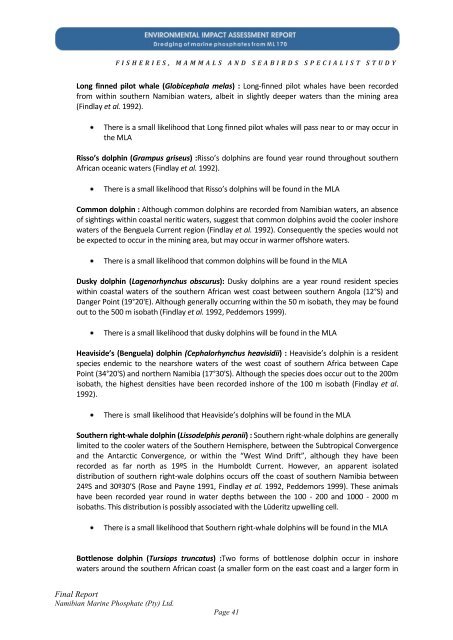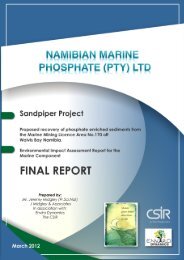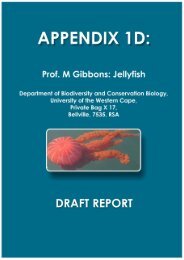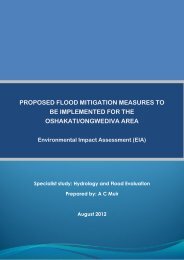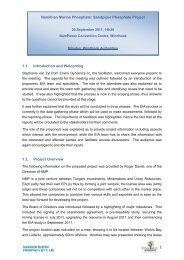Fisheries - Enviro Dynamics Namibia
Fisheries - Enviro Dynamics Namibia
Fisheries - Enviro Dynamics Namibia
You also want an ePaper? Increase the reach of your titles
YUMPU automatically turns print PDFs into web optimized ePapers that Google loves.
F I S H E R I E S , M A M M A L S A N D S E A B I R D S S P E C I A L I S T S T U D Y<br />
Long finned pilot whale (Globicephala melas) : Long-finned pilot whales have been recorded<br />
from within southern <strong>Namibia</strong>n waters, albeit in slightly deeper waters than the mining area<br />
(Findlay et al. 1992).<br />
There is a small likelihood that Long finned pilot whales will pass near to or may occur in<br />
the MLA<br />
Risso’s dolphin (Grampus griseus) :Risso’s dolphins are found year round throughout southern<br />
African oceanic waters (Findlay et al. 1992).<br />
There is a small likelihood that Risso’s dolphins will be found in the MLA<br />
Common dolphin : Although common dolphins are recorded from <strong>Namibia</strong>n waters, an absence<br />
of sightings within coastal neritic waters, suggest that common dolphins avoid the cooler inshore<br />
waters of the Benguela Current region (Findlay et al. 1992). Consequently the species would not<br />
be expected to occur in the mining area, but may occur in warmer offshore waters.<br />
There is a small likelihood that common dolphins will be found in the MLA<br />
Dusky dolphin (Lagenorhynchus obscurus): Dusky dolphins are a year round resident species<br />
within coastal waters of the southern African west coast between southern Angola (12°S) and<br />
Danger Point (19°20'E). Although generally occurring within the 50 m isobath, they may be found<br />
out to the 500 m isobath (Findlay et al. 1992, Peddemors 1999).<br />
There is a small likelihood that dusky dolphins will be found in the MLA<br />
Heaviside’s (Benguela) dolphin (Cephalorhynchus heavisidii) : Heaviside’s dolphin is a resident<br />
species endemic to the nearshore waters of the west coast of southern Africa between Cape<br />
Point (34°20'S) and northern <strong>Namibia</strong> (17°30'S). Although the species does occur out to the 200m<br />
isobath, the highest densities have been recorded inshore of the 100 m isobath (Findlay et al.<br />
1992).<br />
There is small likelihood that Heaviside’s dolphins will be found in the MLA<br />
Southern right-whale dolphin (Lissodelphis peronii) : Southern right-whale dolphins are generally<br />
limited to the cooler waters of the Southern Hemisphere, between the Subtropical Convergence<br />
and the Antarctic Convergence, or within the “West Wind Drift”, although they have been<br />
recorded as far north as 19ºS in the Humboldt Current. However, an apparent isolated<br />
distribution of southern right-wale dolphins occurs off the coast of southern <strong>Namibia</strong> between<br />
24ºS and 30º30’S (Rose and Payne 1991, Findlay et al. 1992, Peddemors 1999). These animals<br />
have been recorded year round in water depths between the 100 - 200 and 1000 - 2000 m<br />
isobaths. This distribution is possibly associated with the Lüderitz upwelling cell.<br />
There is a small likelihood that Southern right-whale dolphins will be found in the MLA<br />
Bottlenose dolphin (Tursiops truncatus) :Two forms of bottlenose dolphin occur in inshore<br />
waters around the southern African coast (a smaller form on the east coast and a larger form in<br />
Final Report<br />
<strong>Namibia</strong>n Marine Phosphate (Pty) Ltd.<br />
Page 41


